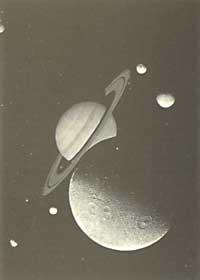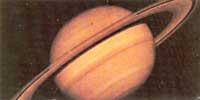Solar System Limit
1990/10/01 Arregi Bengoa, Jesus Iturria: Elhuyar aldizkaria
As in most of the last issues, we will talk about the Solar System again, but approaching its limits. At the end of this study of the border we leave the topics of the near environment to address other topics that until now we have not touched, such as the galaxies and our French Way (Milky Way), the Quasars, etc.
Some examples have tried to explain the conclusions obtained from the data sent by Voyager 2. To dismiss the Solar System we will also leave towards its border with Voyager 2 and three other spaces (Voyager 1, Pioneer 10 and Pioneer 11).
Contrary to the initially imaginable, the limit of the Solar System is not defined taking into account the effects of its gravity field. Among the furthest bodies orbiting around the Sun are the comets that form the Oort cloud, whose radius can be around 50,000 astronomical units (AU, distance between the Sun and Earth, about 150 million km).
But at that distance, let alone, the Sun has no influence on the interstellar medium. Therefore, the limit is considered to be at a limit where this medium eliminates the influence of the Sun's magnetic field. The part of the space exposed to the action of the magnetic field of a body is called the magnetosphere, but in the case of the Sun it is given a special name: heliosphere. The limit is called heliopause.
In short, the Sun is responsible for the physical conditions that exist in the heliosphere. As is known, the violent processes that occur in the Sun generate a flow of charged parts (especially electrons and protons) that leave the photosphere. This flow extends along the interplanetary space creating the so-called solar wind. When these fractions of the solar wind are just released, that is, when they have not yet left the sun, they form the last layer of their atmosphere: the crown.
The speed of the solar wind fractions is usually 400 or 600 km/s. However, it should be noted that the higher the plasma speed emitted by areas of solar latitude the higher. On the other hand, when we study the Sun, we point out that explosions and phenomena that cause alterations in the magnetic field can significantly increase the density and speed of the solar wind.
The speed can reach 2000 km/s. The magnetic lines of the magnetic field are those that delimit the path. Of course, the rotation speed of the Sun has a great influence on this movement. The magnetic field lines are not radial, but spiral, and around the orbit of Neptune they are almost perpendicular to the radial direction.

As for the shape of the heliosphere, it was originally thought to be spherical, but as far as we know today it cannot be spherical. Based on the motion studies of the surrounding stars, astronomers have concluded that the local interstellar medium comes from the center of the galaxy to the Sun at an approximate speed of 20 km/s. Therefore, in the environment where interstellar flow and solar wind collide a shock wave is generated that produces a compression. On the opposite side, the magnetic lines form a long tail following the direction of interstellar flow. The image shows the result of all the considerations made.
On the side between heliopause and shock wave, the intensity of the interstellar magnetic field can be one million or two gausses (the earth's is one-third gauss). When the solar wind reaches this area it does not follow the spiral lines of the Sun's magnetic field, but spreads radially until the shock reaches the wave. Outside it the zones are disordered and the plasma flow is turbulent.
What can we say about the measurements of the heliosphere? The little we know about this problem has been achieved by analyzing the behavior of cosmic rays coming to Earth from interstellar space. The intensity of these rays is variable and coincides with the period of activity of the Sun. When the activity is maximum, the intensity of cosmic rays is minimal and vice versa. The explanation is simple. When the activity is maximum, the solar wind is stronger and the heliosphere expands so that the absorption of cosmic rays is greater.
Logically, when the activity is minimal the effect is reverse. Moreover, the diffusion of the heliosphere also has another consequence: The maximum solar activity and the minimum cosmic rays do not occur at the same time, while the second is delayed between nine months and a year from the first (it is the same, of course, between the minimum activity and the maximum cosmic rays). This delay or lag is due to the fact that the heliosphere diffusion is not instantaneous. Fractions triggered by increased activity take the heliopause to the new place and the absorption of rays from the outside is effective.
This data allows us to calculate an approximation to the distance from the Sun to the frost. If we assume an average solar wind speed of 500 km/s, for 3.3 days an astronomical unit will circulate, so for nine months there will be 80 U.A. and a year with 110 U.A. Normally 100 and 150 U.A. The distance from the Sun to helium is supposed to be in the middle section towards the shockwave side. Towards the side of the queue, however, no accurate data is available to perform the calculation, but the amount of 10,000 U.A is indicated as orientation.
Although the earth moves within the heliosphere, we do not know its differences and behavior well. Although the data sent by the above mentioned spaces are very important, they also present a problem, as we will see in the next issue.
We will finish with a new look at the image to analyze the trajectories of the spaces that move away from the Sun and contemplate their opportunity to pass the heliopause and immerse themselves in the interstellar space. The four boats have the same problem: they have very limited fuel reserves to respond to the long journey they should make to get to the frost. It is located 47 U.A. of the Sun Pioneer 10, but its route is not the most suitable to reach helium. You are at Pioneer 11 29 U.A. and Voyager 2 to 30 U.A., but its trajectory is not the shortest either. Voyager 1, currently 38 U.A. of the Sun, is the most suitable and scientists hope that it will arrive before its energy source is exhausted by 2020.
Sun: Enter Sagittarius on November 22.
Planets in November:
|

Gai honi buruzko eduki gehiago
Elhuyarrek garatutako teknologia





